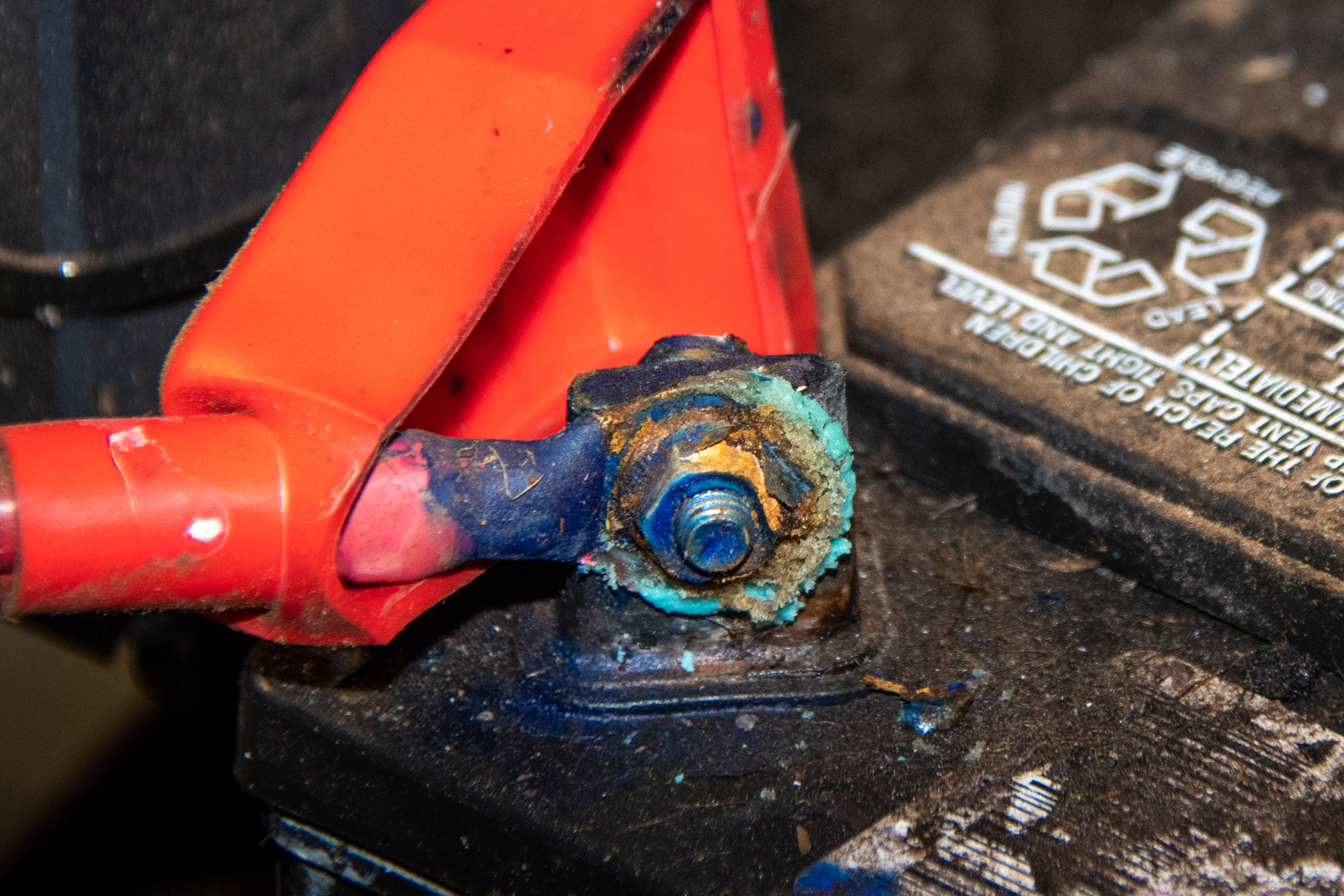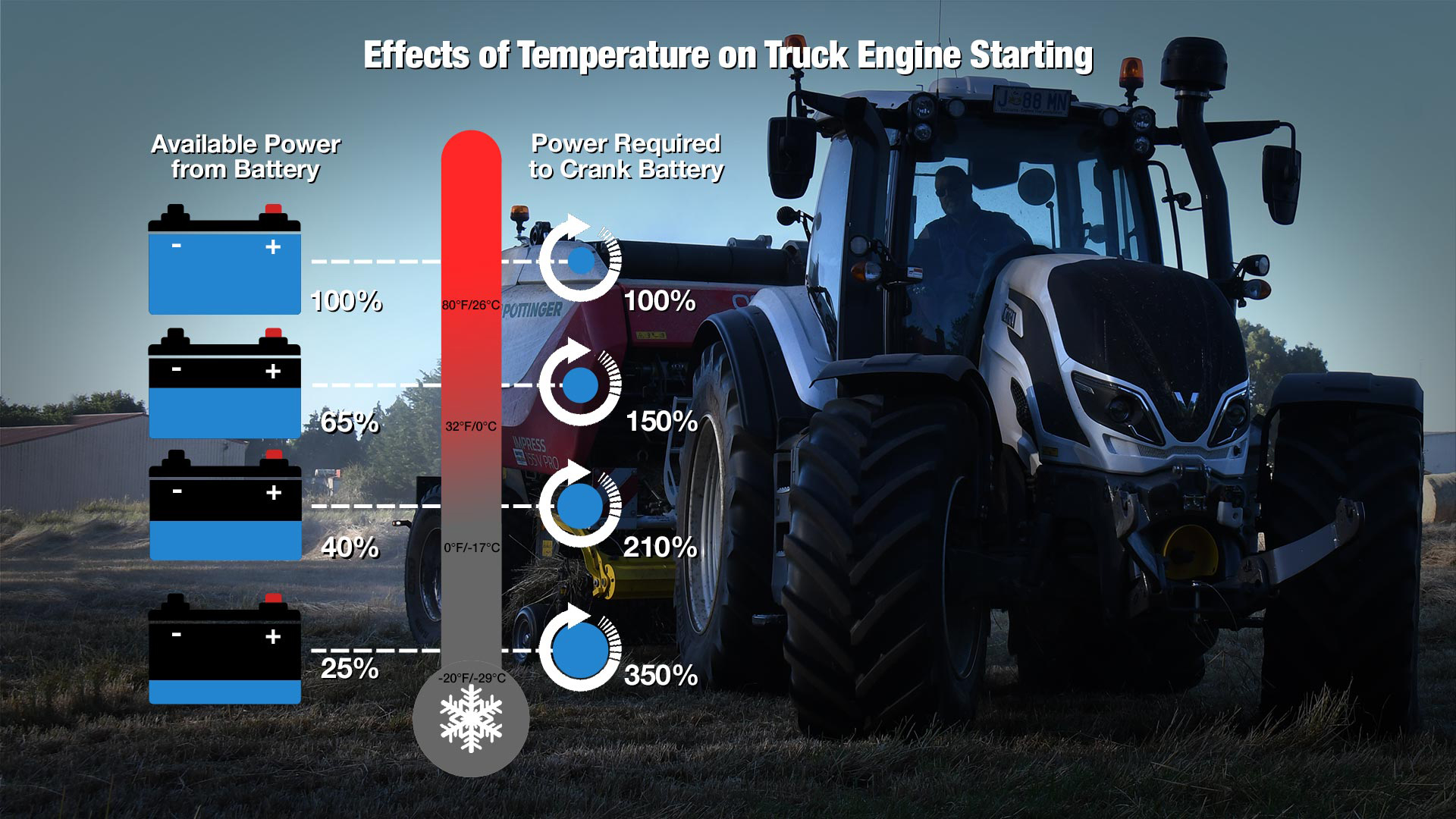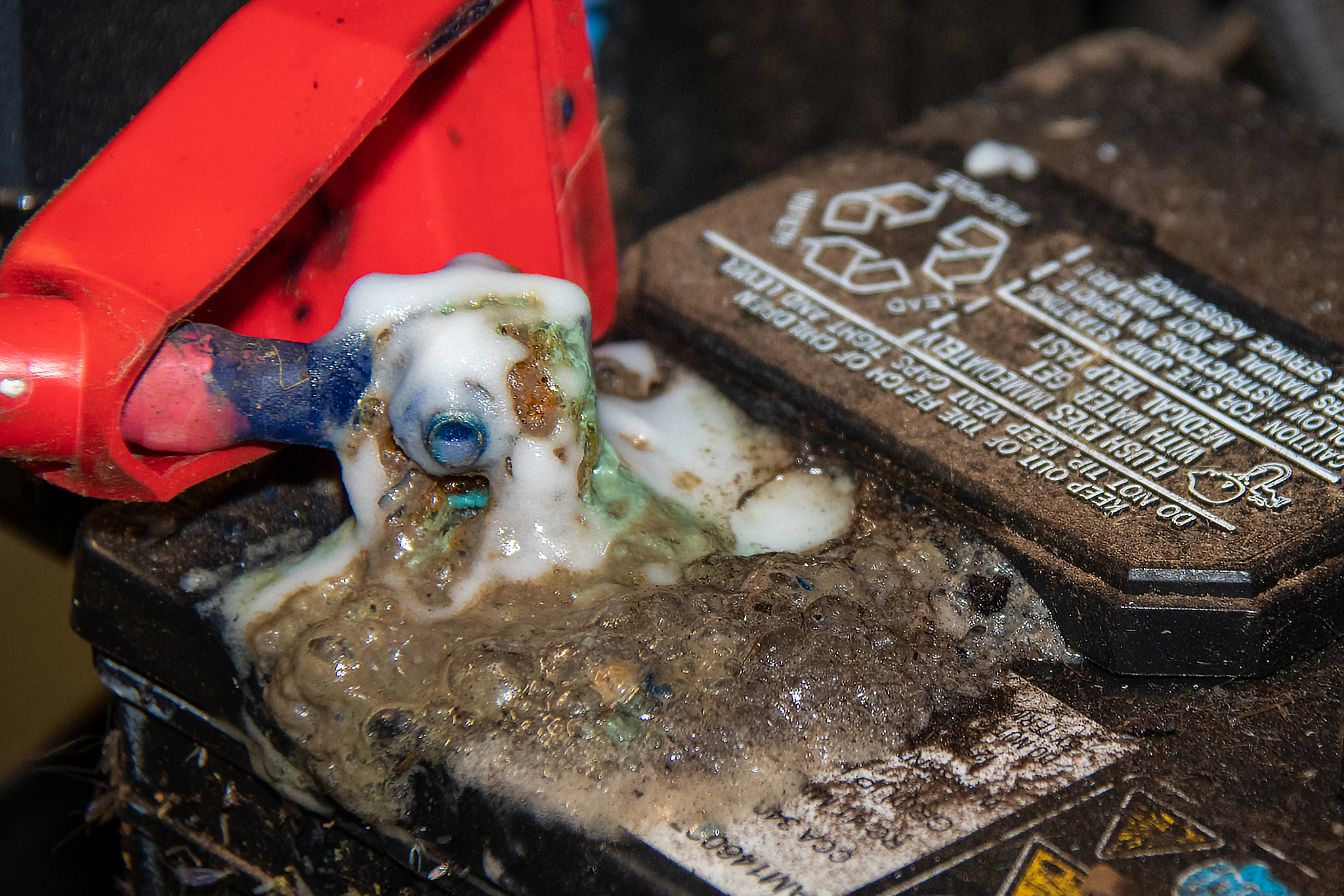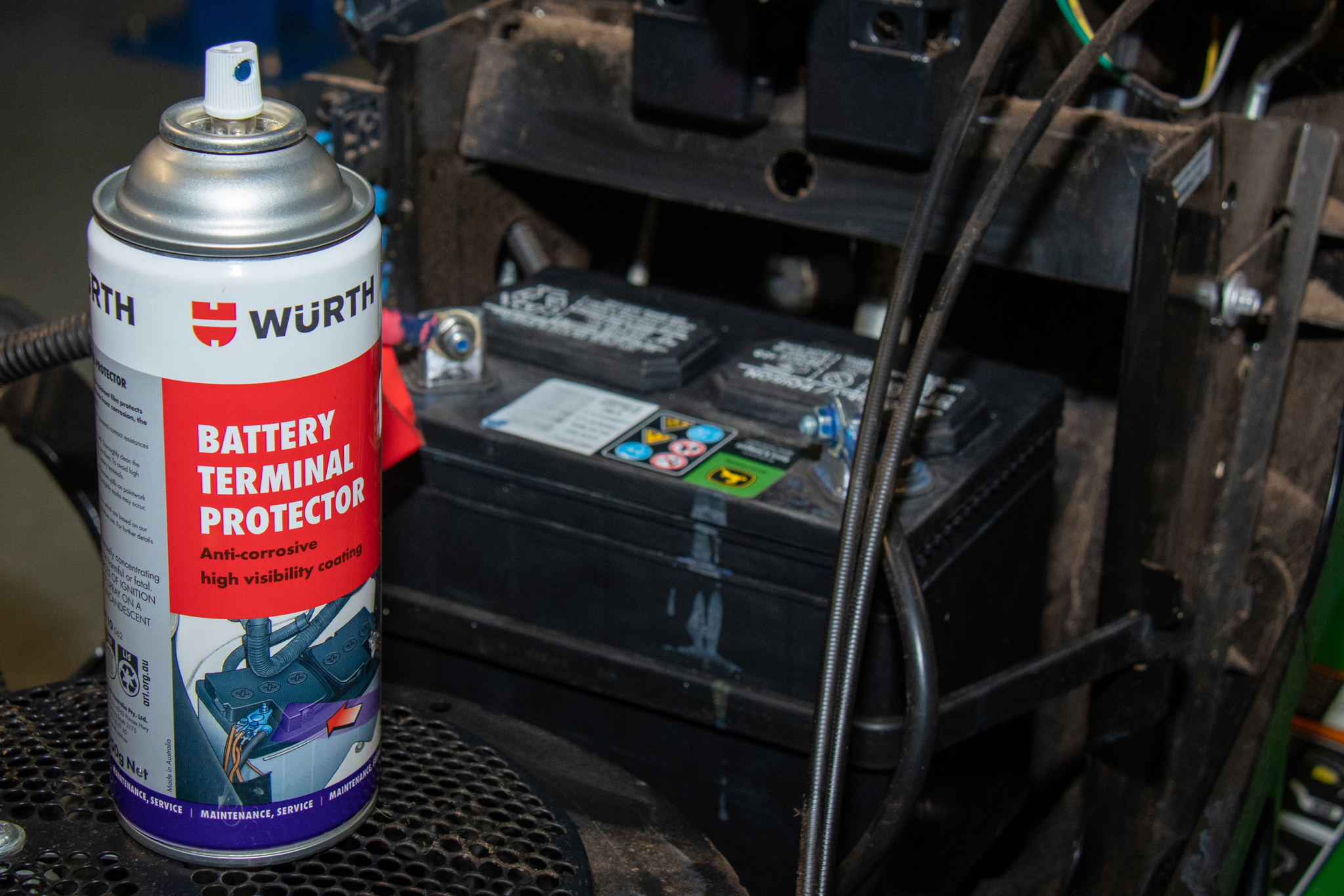If, like me, you live in a cooler climate with long frosty winter mornings, then there is a high probability that you’d have undoubtedly encountered a battery that has failed to crank an engine once or twice.
 But let’s face it, replacing a battery on an icy cold frosty winter morning is no walk in the park. Thankfully, though, there are preventative measures and other maintenance actions that you can carry out to prevent your tractor battery from failing during cold weather.
But let’s face it, replacing a battery on an icy cold frosty winter morning is no walk in the park. Thankfully, though, there are preventative measures and other maintenance actions that you can carry out to prevent your tractor battery from failing during cold weather.
As we head into the winter months, it’s essential to think about battery maintenance. Both active and inactive machines require attention to prevent the battery from discharging in winter storage or keeping you working through the cold weather.
Ask any classic car collector what’s the number one headache involved in keeping their prized car running, and they will likely answer, “Dead batteries!” It’s little wonder, too, since classic cars often don’t get the running time needed to keep their batteries in prime condition. As a result, a battery that receives little to no maintenance and not regularly recharged faces premature failure. If truth be told, a colossal two-thirds of tractor batteries never reach their total designed life cycle due to lack of battery maintenance.
 Inactive batteries, especially those sitting in tractors during long winter months of storage, slowly lose their charge to parasitic drain. When this occurs, sulphur molecules in the sulfuric acid that constitutes a battery’s electrolyte solution attach themselves to its lead plates. Unfortunately, that sulphur can coat the plates so thoroughly that it prevents the battery from being recharged in a surprisingly short time (often less than a couple of months). The number one cause of battery failure is known as sulfation. Certainly, disconnecting the cables from a tractor battery going into storage is a good start. But, even then, a fully charged battery in storage will deplete itself at a rate of one per cent discharge per day.
Inactive batteries, especially those sitting in tractors during long winter months of storage, slowly lose their charge to parasitic drain. When this occurs, sulphur molecules in the sulfuric acid that constitutes a battery’s electrolyte solution attach themselves to its lead plates. Unfortunately, that sulphur can coat the plates so thoroughly that it prevents the battery from being recharged in a surprisingly short time (often less than a couple of months). The number one cause of battery failure is known as sulfation. Certainly, disconnecting the cables from a tractor battery going into storage is a good start. But, even then, a fully charged battery in storage will deplete itself at a rate of one per cent discharge per day.
 Consequently, most tractor manufacturers recommend removing the battery from the tractor and keeping it charged while in storage. However, storing batteries on concrete floors does not cause them to discharge any faster than if they are sitting on a piece of timber. This myth was circulated during the early 1900s when battery cases made of porous material were common. Today’s polypropylene or hard rubber-encased batteries with better-sealing properties eliminate external leakage, so discharge is no longer a problem.
Consequently, most tractor manufacturers recommend removing the battery from the tractor and keeping it charged while in storage. However, storing batteries on concrete floors does not cause them to discharge any faster than if they are sitting on a piece of timber. This myth was circulated during the early 1900s when battery cases made of porous material were common. Today’s polypropylene or hard rubber-encased batteries with better-sealing properties eliminate external leakage, so discharge is no longer a problem.
Remember that wherever you choose to store your batteries, be sure the area is not subject to freezing or high temperatures. Incidentally, high temperatures are more harmful to batteries. For example, a battery stored at 35° Celsius will self-discharge twice as fast as one stored at 24° Celsius.
 The investment in a regulated charger that will maintain a battery at normal levels for extended storage periods will not go unrewarded. These intelligent or ‘smart’ chargers incorporate a microprocessor that senses when a battery has reached its peak charge and subsequently switches to a float mode. This feature maintains voltage at a level sufficient to keep a battery from discharging, preventing it from being overcharged.
The investment in a regulated charger that will maintain a battery at normal levels for extended storage periods will not go unrewarded. These intelligent or ‘smart’ chargers incorporate a microprocessor that senses when a battery has reached its peak charge and subsequently switches to a float mode. This feature maintains voltage at a level sufficient to keep a battery from discharging, preventing it from being overcharged.
One critical component of a battery’s function is the condition of the terminals. Extreme battery terminal corrosion can also destroy your battery cables over time. Moreover, it can cause a spark to damage your battery terminal, leading to a battery rupture in a worst-case scenario. However, you can keep your battery functioning safely and correctly and extend your battery’s lifespan with regular maintenance. But before we get to how to clean and remove battery corrosion, let’s investigate the cause of corrosion first.
 Battery terminal corrosion causes?
Battery terminal corrosion causes?
The most common trigger of battery terminal corrosion is when the battery acid causes a chemical reaction with the metal terminals. Corrosion typically appears as a flaky layer of brown, white, or green discolouration that sits on your battery terminals. It’s important to note the colour of the build-up collected on your terminals because it indicates the difference between corrosion and sulfation.
 What is the difference between corrosion and sulfation?
What is the difference between corrosion and sulfation?
Although these two corrosive processes produce relatively similar-looking discharges, there are some critical distinctions between corrosion and sulfation.
- Corrosion appears when the battery acid reacts with the metal terminals, typically when they become loose. It is brown, white, or blue/green.
- Sulfation occurs when lead sulphate crystals build up on the battery terminal because the battery is not maintaining a regular charge. It is usually grey.
Identifying the difference between these two chemical reactions is essential because eliminating corrosion forms part of a regular maintenance routine. Sadly, however, sulfation typically indicates more severe damage to the battery. Consequently, once the sulfation stage occurs, the only option is battery replacement.
 Cleaning Corroded Battery Terminals
Cleaning Corroded Battery Terminals
Although it’s not always possible to prevent corrosion, it’s easy to clean off. For example, cleaning corroded battery terminals is easier than it sounds.
You will need:
- Acid-resistant rubber or nitrile gloves and safety glasses
- A wire brush, emery paper and fine file
- Baking soda & water to form a paste
- Jug to mix the paste
- Paper towel or shop rag
- Suitable tools to remove tractor battery
- Battery charger
- Battery terminal protector
 Ten easy steps to restore your battery to peak condition:
Ten easy steps to restore your battery to peak condition:
- Make sure your tractor ignition is in the “OFF” position.
- Make up a paste with two parts baking soda and one part water.
- Carefully apply the past to the battery terminal with a rag to neutralise the acid.
- Avoid touching the battery and components with your bare hands. Use a small wire brush and emery paper to clean the battery of the majority of the corroded material.
- Work the baking soda mixture into the terminals using your wire brush.
- Meticulously wipe off any excess solution from the terminals with a rag or paper towel.
- Remove the battery from the tractor.
- Thoroughly clean the battery terminal with a wire brush and gently file the contact surface of the terminal flat with a fine file.
- Give the battery a full charge while out of the tractor.
- Reconnect the fully charged battery to the tractor.
- Finally, spray a generous coat of Battery Terminal Protector on the terminals to reduce corrosion forming.
Generally, removing corrosion from your battery is an easy means of keeping it in a safe condition and getting the most out of your battery. However, it is advisable to complete this process before and after long storage periods to guarantee a positive connection between the battery and machine.
Don’t forget that tractors required to work during winter need a fully charged battery to ensure they have enough power to crank the starter motor on cold mornings. Typically, batteries kept below a 70 per cent state of charge will struggle to start a cold engine. In addition, because batteries produce less energy at colder temperatures, the overall condition of battery charge is also lowered.






